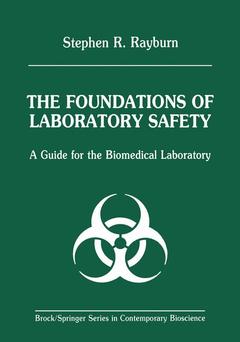Description
The Foundations of Laboratory Safety, Softcover reprint of the original 1st ed. 1990
A Guide for the Biomedical Laboratory
Brock Springer Series in Contemporary Bioscience Series
Language: English
Subjects for The Foundations of Laboratory Safety:
Keywords
Biomedical Laboratory; DNA; Laboratory; Laboratory Techniques; Viruses
Publication date: 09-2011
418 p. · 17.8x25.4 cm · Paperback
418 p. · 17.8x25.4 cm · Paperback
Description
/li>Contents
/li>
Safety is a word that has many connotations, of risk ofa possible accident that is acceptable conjuring up different meanings to different to one person· may not be acceptable to an people. What is safety? A scientist views safety other. This may be one reason why skydiving as a consideration in the design of an exper and mountain climbing are sports that are not iment. A manufacturing plant engineer looks as popular as are, say, boating or skiing. on safety as one of the necessary factors in But even activities that have high levels of developing a manufacturing process. A legis potential risk can be engaged in safely. How lator is likely to see safety as an important part can we minimize risks so that they decrease of an environmental law. A governmental ad to acceptable levels? We can do this by iden ministrator may consider various safety issues tifying sources of hazards and by assessing the when reviewing the environmental conse risks of accidents inherent to these hazards. quences of a proposed project. An attorney Most hazards that are faced in the laboratory may base a negligence suit on safety defects.
1 Basic Principles of Laboratory Safety.- 1 Safe Laboratory Techniques.- 2 Protective Clothing and Personal Equipment.- 3 Safe Personal Habits and Practices.- 4 Housekeeping Procedures.- 5 Principles of Decontamination and Sterilization.- 2 Laboratory Facilities, Operations, and Practices 67.- 6 Specialized Equipment Facilities.- 7 Waste Disposal in the Research Laboratory.- 8 Glassware Washing Operations.- 9 Design and Use of Biological Safety Cabinets.- 10 Facility Design and Physical Containment.- 3 Biomedical Laboratory Safety.- 11 Hazards of Biological Agents.- 12 Chemical Hazards.- 13 Hazards of Radioisotopes.- 4 Control of Common Hazards.- 14 Physical and Mechanical Hazards.- 15 Electrical Hazards.- 16. Fire Hazards.- 17. Handling Compressed Gases.- 5 The Components of the Effective Safety Program.- 18. Safety Regulations and Standards.- 19. Personnel Orientation and Training.- 20. Role of Medical and Health Factors.- 21. Accident Reduction and Emergency Planning.- 22. Designing a Safety Program.- Appendix 1: Cleaning Up Spills of Hazardous Agents.- Appendix 2: Hazard Characteristics of Common Toxic Chemicals.- Appendix 3: Hazard Warning Signs and Labels.- Appendix 4: Packaging and Shipping Hazardous Materials.- Appendix 5: Resources for Help and Information.- Appendix 6: Syllabus for a Safety Course.- References.- Additional Readings.
© 2024 LAVOISIER S.A.S.

